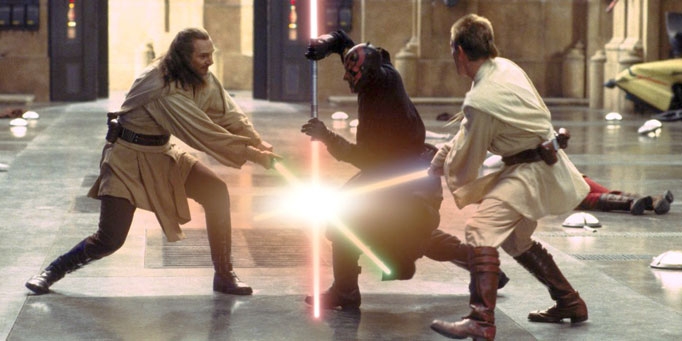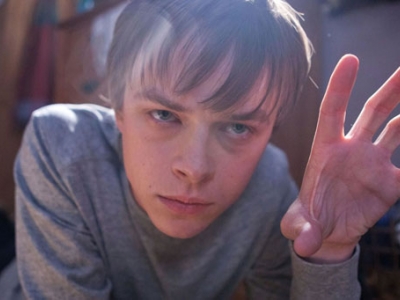
The 5 spiritual laws of Star Wars
With the recent re-release of 'The Phantom Menace', Mark Hadley explores the theological side of Star Wars.
For the first time...
Every now and then a scene in a film comes back to you as an astute observation about the nature of things. Men In Black is not the most philosophical production, but it did provide me with just such an insight. Agent K (Tommy Lee Jones) introduces Agent J (Will Smith) to a small disc the size of his fingernail that is the next step in high fidelity recording technology and exclaims, “Guess I’ll have to buy The White Album all over again”. I think of that big screen moment every time Star Wars raises itself from the grave in yet another updated form…
This month marks the release of Star Wars Episode 1 – The Phantom Menace “… for the first time – in 3D”. If you’re old enough, you’ll know this is not the first time Lucas Arts has used the phrase ‘the first time’. I remember the films being released for the first time on VHS, the first time in THX Surround Sound, the first time in Wide Screen, the first time on DVD and, recently, for the first time on BluRay. I’ve also lost count of the times they’ve been re-released to the cinemas to mark anniversaries and the debut of additional episodes. And let’s not forget the endless supply of toys, t-shirts and Tupperware that has backed up the franchise. Suffice to say it’s hard to believe there’s anyone out there over the age of two who hasn’t at least a passing familiarity with the Jedi and their epic storyline. So I won’t waste time recapping it here.

I do think there’s an argument for focusing our attention on the spiritual content of the series, especially for parents considering taking their children to enjoy the sheer spectacle of this latest release on the big screen. Unlike many long-running franchises, Star Wars deliberately advances a theology that rules the worlds it has created. We’d do well to recognize its elements so we know what to promote and what to challenge. Here are my five key points to keep in mind.
The 5 spiritual laws of Star Wars
1. The Jedi: When Alec Guiness replaces Ewan McGregor, Obi Wan Kenobi will describe these light-sabre wielding warriors as “… the guardians of peace and justice in the galaxy.” But attaining their level of personal peace and insight involves a detachment from the world that would rival a Shaolin monk. No marriage, no attachment, no emotion is a creed more at home in Buddhism than Christianity. The idea that we can detach ourselves from life, and rise to spiritual perfection is not an approach you’d want to encourage in any young mind. In that direction, great suffering I perceive.
2. The Force: “Life creates it,” Yoda tells a young Skywalker, and it surrounds and permeates all things. What George Lucas introduced to the world as the cosmic energy behind all things is probably better known in Hinduism as Brahman, the great flame from which all things emerge and long to return. There’s no hope trying to equate it with Christianity’s Father God. It is impersonal and uninterested in any of our merely human concerns.
3. Life after death: Young Jedi learn to manipulate the Force; older Jedi look to be remade by it. Star Wars lore has it that The Phantom Menace’s Qui-Gon Jinn was the first Jedi to discover a way of retaining his identity after being absorbed back into the Force. Ever since then the Star Wars universe seems to have been overrun with ghostly Jedi popping back up to offer a bit of helpful advice. Not only does this make eternal life the property of the ‘truly spiritual’ but creates something of a reincarnation cycle. Hebrews 9 holds out a different method with a different result: “Just as people are destined to die once, and after that to face judgment, so Christ was sacrificed once to take away the sins of many; and he will appear a second time, not to bear sin, but to bring salvation to those who are waiting for him.”
4. The Dark Side: This is basically where the bad Jedi end up. In Episode I Yoda explains to a young Anakin that “Fear leads to anger; anger leads to hate; hate leads to suffering”. If he gives in to these negative influences, his life will be dominated by ‘the dark side’ of the Force. It’s this dualism that is at the heart of all Star Wars conflict. Evil can’t be eliminated, but it can be held in balance. This is what the Jedi are hoping their ‘chosen one’ will achieve. The Bible holds out a greater hope. Evil isn’t permanent; it’s an aberration that will one day be defeated forever. That’s what our ‘chosen one’, Jesus, achieved on the cross. The dark side has had its day and dawn is coming.
5. A moral universe: In a post-modern world it’s actually good to see that one of our favourite modern myths maintains there are such things as universal truths, that good and bad are not matters of perspective and you can actually fight on the side of right. Also, those who practice evil will be destroyed, unless they choose to show real repentance. And the Star Wars universe is moving towards a point where peace will flow like a river through the galaxy. Almost makes you want to get out a light sabre and join the fun.
The Phantom Menace is the beginning of a grand arc that, despite it’s many flaws, appeals to audiences at key points precisely because God designed us to appreciate the truths it reflects. Its story resonates with His story – history. And yes, the other five are also on their way, “For the first time! … in 3D.”
Watching The Phantom Menace with your kids
Phantom Menace is really the territory for primary school children thanks to the sanitized violence and the antics of Jar Jar Binks. And since I plan to take two boys under ten myself, I’ll be aiming to use one of the following:
- Who was your favourite character – what was the best thing about them?
- Why did the Jedi keep risking their lives?
- Does Anakin have to turn into Darth Vader?
For more articles from Growing Faith, subscribe to our monthly e-newsletter.
To hear about the latest books and resources from Youthworks Media, subscribe here.







